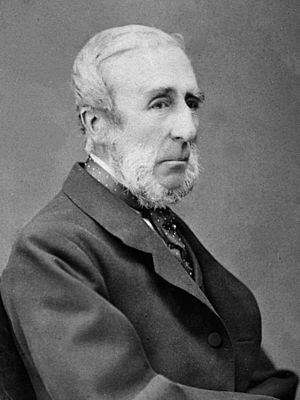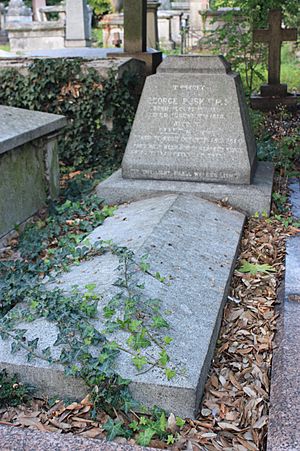George Busk facts for kids
Quick facts for kids
George Busk
FRS FRAI
|
|
|---|---|
 |
|
| Born | 12 August 1807 |
| Died | 10 August 1886 (aged 78) London, United Kingdom
|
| Resting place | Kensal Green Cemetery, London |
| Nationality | British |
| Occupation | Surgeon |
| Title | |
| Spouse(s) | Ellen Busk (1843–1886) |
| Children | Two daughters |
| Awards |
|
| Signature | |
 |
|
George Busk was an important British scientist. He was born on August 12, 1807, and died on August 10, 1886. He worked as a surgeon for the navy. He was also a zoologist, studying animals, and a palaeontologist, studying ancient life forms like fossils.
Contents
George Busk's Early Life
George Busk was born in St. Petersburg, Russia. His father, Robert Busk, was a merchant. His grandfather, Sir Wadsworth Busk, was a lawyer.
George went to Dr. Hartley's School in Yorkshire, England. He later studied surgery in London. He attended both St Thomas' Hospital and St Bartholomew's Hospital.
George Busk's Career
In 1832, Busk became an assistant-surgeon. He worked at the Greenwich Hospital. He also served as a naval surgeon on two ships. First, he was on HMS Grampus. Later, he served for many years on HMS Dreadnought. This ship had fought in the famous Battle of Trafalgar.
During Busk's time, the Dreadnought was a hospital ship. It helped sailors from the Merchant Navy and fishing fleets. While working there, Busk learned a lot about diseases. He made important observations about cholera and scurvy.
Focusing on Science
In 1855, George Busk retired from medicine. He moved to London. There, he spent his time studying zoology and palaeontology. Zoology is the study of animals. Palaeontology is the study of fossils and ancient life.
Busk also helped edit scientific journals. From 1853 to 1868, he edited the Quarterly Journal of Microscopical Science. He also edited the Natural History Review from 1861 to 1865.
He was part of a group called the X-Club. This group was started by T. H. Huxley. They worked to make science more important in England. Busk and his wife, Ellen, were good friends with Huxley. Busk also helped Charles Darwin get a special award. It was called the Copley Medal, the highest award from the Royal Society.
Important Roles in Science
From 1856 to 1859, Busk taught at the Royal College of Surgeons. He taught about Comparative Anatomy and Physiology. He later became the President of the college in 1871.
He was elected a Fellow of the Royal Society in 1850. This is a very high honor for a scientist. Busk was also active in other important scientific groups. These included the Linnean Society and the Geological Society. He was also president of the Ethnological Society and the Anthropological Institute.
Busk received several major awards for his work. These included the Royal Medal, the Wollaston Medal, and the Lyell Medal.
Studying Ancient Life
George Busk was a top expert on tiny sea creatures called Polyzoa. Later, he studied bones from ancient animals found in caves and rivers.
In 1862, Busk visited Gibraltar again. He helped bring a very important fossil to England. It was called the Gibraltar skull. This skull was found in 1848. It was the second Neanderthal fossil ever found. It was also the first adult Neanderthal skull known. However, scientists did not realize it was a Neanderthal until the 20th century.
Personal Life and Death
On August 12, 1843, George Busk married Ellen Busk. She was his first cousin. They had two daughters together.
George Busk passed away in London on August 10, 1886. He is buried at Kensal Green Cemetery in London.


